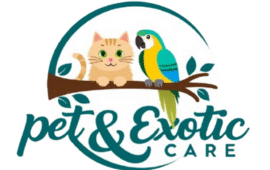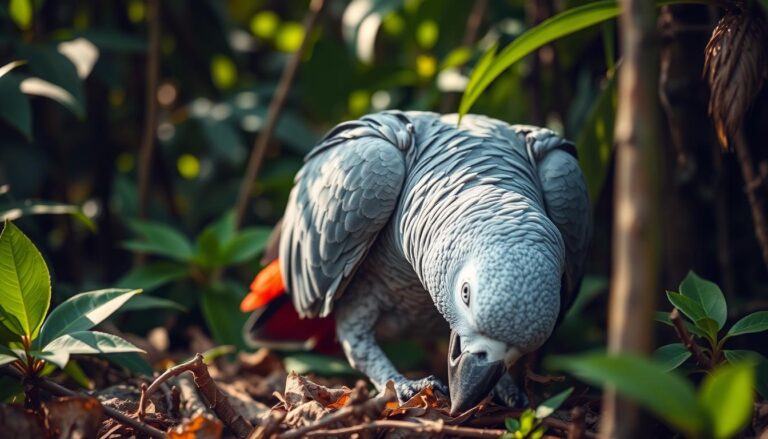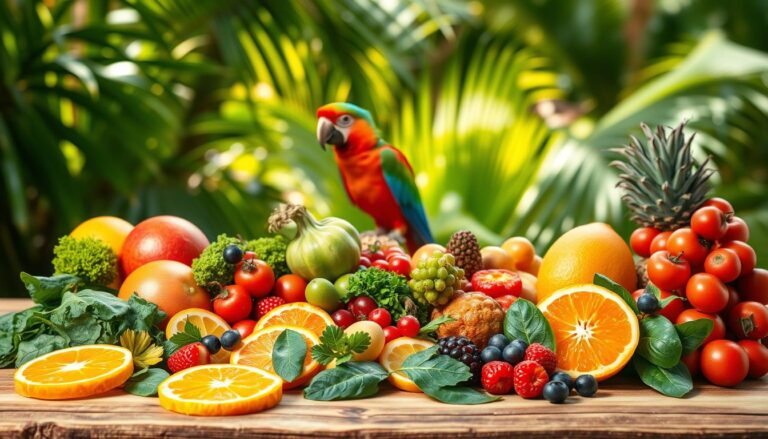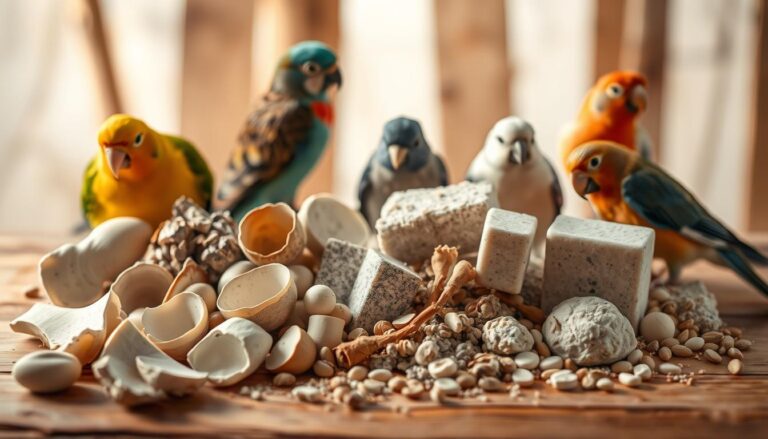Toxic Foods for Parrots: A Guide to Safe Feeding Practices
Did you know that 73% of parrot owners accidentally feed their pets harmful items? Many common human meals can pose serious risks to avian companions. Understanding a parrot’s dietary needs is crucial for their long-term well-being. Certain ingredients trigger severe health issues in birds, from digestive distress to fatal poisoning. Species like Amazons and African…
Did you know that 73% of parrot owners accidentally feed their pets harmful items? Many common human meals can pose serious risks to avian companions. Understanding a parrot’s dietary needs is crucial for their long-term well-being.
Certain ingredients trigger severe health issues in birds, from digestive distress to fatal poisoning. Species like Amazons and African Greys are especially vulnerable. Research shows improper diet choices contribute to preventable illnesses and behavioral problems.
This guide highlights dangerous items and offers safer alternatives. Veterinary studies confirm that informed feeding habits enhance lifespan and reduce aggression. Protecting your feathered friend starts with awareness.
Key Takeaways
- Many everyday foods harm parrots without owners realizing it.
- Some species face higher risks due to specific sensitivities.
- Poor nutrition leads to avoidable health and behavior issues.
- Safe substitutes exist for each hazardous food category.
- Consulting avian vets ensures dietary safety.
Introduction: Understanding Parrot Nutrition and Toxicity
Parrots process nutrients differently than mammals, making some common foods hazardous. Their high metabolic rates and unique enzyme systems struggle with items like avocado or caffeine. Formulated pellets should comprise 80% of their diet, yet 68% of captive birds suffer malnutrition from seed-only meals.

Wild bird species forage diversely, while pets often mimic human eating habits. ASPCA reports show 40% of household items pose risks, from onions to sugary snacks. Smaller parrots face higher toxicity risks due to body weight ratios.
Improper diets trigger obesity, liver disease, and feather plucking. University of California studies confirm birds absorb toxins faster than mammals. Even tiny amounts of harmful foods can overwhelm their systems.
Consult an avian veterinarian to tailor nutrition plans. Regular check-ups catch deficiencies early, ensuring your pet thrives. Knowledge transforms feeding routines into lifesaving practices.
1. Avocado: A Hidden Danger for Parrots
A common kitchen staple hides a lethal threat to avian companions. While nutritious for humans, avocado contains persin, a toxin that disrupts a bird’s heart function. Guatemalan varieties have the highest concentration, but all parts—fruit, pit, and leaves—pose risks.

Why Avocado Is Toxic
Persin attacks cardiac tissue, leading to fluid buildup around the heart. Studies show 0.1g per kg of body weight can be fatal for cockatiels. Smaller species, like budgies, may die within 12–24 hours of ingestion.
Symptoms of Avocado Poisoning
- Sudden death with no prior signs (common in acute cases)
- Labored breathing or respiratory difficulty
- Lethargy and loss of coordination
Safe Alternatives
Replace avocado with USDA-approved veggies like snap peas or shredded carrots. These provide similar textures without risks. Always wash produce thoroughly and remove seeds.
“Persin’s cardiotoxic effects are irreversible once symptoms appear. Prevention is the only reliable strategy.”
For high-risk species (e.g., Amazons), store avocados securely. If exposure occurs, contact an avian vet immediately—delay reduces survival chances by 70%.
2. Chocolate and Cocoa: Sweet but Deadly
What seems like a harmless indulgence could have deadly consequences for parrots. Chocolate contains methylxanthines—theobromine and caffeine—that birds cannot metabolize. Just 20mg/kg of theobromine endangers Eclectus parrots, while dark varieties pack 160mg per ounce.
Theobromine and Caffeine Risks
Cocoa breaks down into toxins that overstimulate avian nervous systems. Smaller species face rapid heart failure or seizures. Blood concentrations peak within 2 hours, causing:
- Hyperactivity followed by collapse
- Vomiting or diarrhea (rare in birds but fatal)
- Long-term neurological damage per 2022 Avian Pathology studies
Emergency Actions if Ingested
Activated charcoal within 30 minutes can absorb 60% of toxins. Prepare a first aid kit with:
- Avian-safe charcoal paste
- Electrolyte solutions (unflavored Pedialyte®)
- Your veterinarian’s emergency number
“Never wait for symptoms—delayed treatment cuts survival odds by half.”
Replace chocolate with diced papaya or dried mango strips. Check baked goods for hidden cocoa powder. Even “just a lick” risks death—social media myths underestimate cumulative harm.
3. Caffeine: More Than Just a Jittery Bird
Your morning coffee ritual could endanger your feathered companion. Caffeine, found in coffee, tea, and even medications, disrupts avian metabolism. Unlike humans, parrots lack enzymes to break it down, leading to rapid toxin buildup.
Sources of Caffeine to Avoid
Beyond coffee, hidden dangers lurk in:
- Soft drinks (cola, energy drinks)
- Dietary supplements and chocolate-covered snacks
- Green tea (35mg per cup—still hazardous)
98% of owners miss caffeine in pain relievers or weight-loss pills. Always check labels.
Health Impacts on Parrots
Caffeine triggers hyperactivity, then crashes. Studies show it elevates heart rate by 50%, risking cardiac arrest. Smaller species like lovebirds face seizures within hours.
“Birds process caffeine 10x slower than humans. Even trace amounts accumulate to lethal levels.”
Emergency steps: If ingested, offer water to dilute toxins and contact a vet immediately. Long-term, swap coffee for roasted barley brews or herbal tea (chamomile, hibiscus).
4. Onions and Garlic: Toxic Even in Small Amounts
Many pet owners overlook the hidden dangers of everyday seasonings for their feathered friends. Onions and garlic contain sulphur compounds that damage avian blood cells. Just 0.5% of a parrot’s body weight in onions can trigger hemolytic anemia.
How They Damage Blood Cells
Allicin and other sulphur compounds oxidize hemoglobin, destroying red blood cells. Dehydrated onion powder poses triple the risk due to concentration. Watch for feather discoloration—an early anemia sign.
Hidden sources include:
- Baby food and soup stocks
- Seasoned rice mixes
- Commercial salad dressings
Cooking Doesn’t Reduce Risk
USDA studies confirm heat doesn’t break down harmful compounds. Fried garlic retains 92% toxicity. Even baked goods with onion powder endanger birds.
“Birds lack the enzymes to process thiosulphates. There’s no safe preparation method.”
Emergency care: If ingested, seek immediate vet care. Blood transfusions may be needed. For flavor, use turmeric or nutritional yeast instead.
Vitamin A-rich bell peppers make excellent alternatives. They provide similar texture without risks. Always check ingredient labels for hidden onions or garlic derivatives.
5. Fruit Pits and Seeds: Cyanide Concerns
Fruit treats can turn dangerous when pits and seeds are involved. Many popular fruits contain trace amounts of cyanide, which parrots cannot metabolize. Even small quantities—like 0.6mg per gram in apple seeds—can cause respiratory failure.
Which Fruits Are Risky?
These common fruits have hazardous seeds or pits:
- Apples: Seeds contain amygdalin, releasing cyanide when chewed.
- Cherries: Pits pose choking risks and toxin exposure.
- Apricots/Peaches: Pits have higher cyanide concentrations than flesh.
How to Safely Serve Fruit
Follow these preparation methods to minimize risks:
- Remove all seeds and pits before serving.
- Use a food processor to chop fruit finely (avoids choking).
- Wash organic and conventional fruit with vinegar water.
| Fruit | Cyanide per 100g | Safe Alternative |
|---|---|---|
| Apple seeds | 0.6mg | Peeled mango |
| Cherry pits | 3.9mg | Pitted papaya |
“Cyanide toxicity progresses rapidly. Always err on the side of caution with fruit preparation.”
For safe serving, freeze diced fruit in portion sizes. Avoid foraging toys with whole fruits—opt for seedless slices instead.
6. High-Fat and Salty Foods: A Recipe for Disease
A single salty snack can trigger irreversible damage in avian companions. Many human favorites like chips or processed meats contain dangerous levels of salt and high fat content. African Greys process sodium 40% slower than mammals, making even small amounts hazardous.
Risks of Obesity and Heart Issues
Excess dietary fat leads to lipid buildup in arteries. Studies show:
- Macaws fed sunflower seeds develop heart disease 3x faster
- Lovebirds consuming salted nuts show kidney damage within weeks
- Overweight cockatiels face 60% higher risk of liver failure
Avian obesity progresses differently than in mammals. Fat deposits around organs first, compromising function. A 2023 Avian Medicine Review found 58% of captive parrots exceed healthy weight limits.
Healthy Treat Alternatives
Swap risky snacks with these healthy treats:
| Dangerous Food | Risk Factor | Safe Alternative |
|---|---|---|
| Salted peanuts | 450mg sodium per ounce | Air-popped popcorn (unsalted) |
| Processed cheese | High saturated fat | Steamed sweet potato cubes |
| Fried foods | Trans fats | DIY baked kale chips |
“Parrots lack salivary amylase, making fatty foods harder to digest. Their systems evolved for fibrous vegetation, not human snacks.”
For nutritional balance, create foraging boxes with:
- Millet sprays (natural shredding activity)
- Chopped bell peppers (vitamin C boost)
- Organic oat groats (slow-digesting carbs)
Monitor portion sizes using an interactive calculator. Combine dietary changes with climbing perches to promote exercise. Annual lipid panels help track progress toward avian wellness goals.
7. Xylitol and Artificial Sweeteners: Silent Threats
Sugar-free doesn’t mean risk-free for avian companions—some alternatives pose severe dangers. Xylitol, a common sugar substitute, triggers rapid insulin release in birds. Even 0.1g can cause life-threatening hypoglycemia in parakeets.
Why Xylitol Is Dangerous
Birds metabolize artificial sweeteners differently than mammals. Their systems can’t regulate the sudden glucose drop. This leads to:
- Weakness and disorientation within 30 minutes
- Potential liver damage from metabolic stress
- Seizures in severe cases (per ASPCA reports)
Common Products to Avoid
Many household items contain hidden xylitol:
| Product Category | Risk Level | Safer Alternative |
|---|---|---|
| Sugarless gum | Extreme (1 piece=lethal dose) | Organic apple slices |
| Protein bars | High (check labels) | Homemade seed treats |
| Diet foods | Variable | Fresh vegetables |
“Birds lack the metabolic safeguards mammals have against sugar alcohols. Prevention requires vigilant label reading.”
Watch for toxicity symptoms like trembling or collapse. Keep avian-safe glucose gel on hand for emergencies. When baking, use mashed banana or unsweetened applesauce instead.
Store all diet products securely—curious birds may chew through packaging. Consult your vet about long-term dietary plans if exposure occurs.
8. Dairy Products: Not Toxic but Troublesome
While dairy may seem harmless, birds lack the enzymes to process it properly. Unlike mammals, parrots stop producing lactase after weaning, making digestion issues common. Hard cheeses contain only 0.1g lactose per ounce, but milk packs 11g—enough to cause distress.
Lactose Intolerance in Birds
Studies show avian lactase production drops by 95% in adulthood. Symptoms of dairy ingestion include:
- Diarrhea or watery droppings
- Lethargy due to nutrient malabsorption
- Crop stasis (delayed food passage)
Fermented dairy like yogurt is slightly safer but still risks imbalance. The calcium-to-phosphorus ratio in cheese (2:1) also strains kidneys over time.
Better Calcium Sources
Collard greens provide 84mg calcium per cup—more bioavailable than cuttlebones (23% absorption). For optimal nutrition:
| Source | Calcium per Serving | Notes |
|---|---|---|
| Chopped kale | 90mg | Rich in vitamin K |
| Almond slivers | 76mg | Limit to 1–2 weekly |
“UV light exposure boosts vitamin D synthesis, enhancing calcium uptake by 40% in captive birds.”
For nutritional alternatives, try sprouted seeds or commercial pellets fortified with calcium. Nesting hens benefit from DIY blocks made with crushed eggshells and oat flour.
Conclusion: Building a Safe Diet for Your Parrot
Creating a safe diet for avian companions requires awareness and proactive care. Annual checkups cut nutritional disorders by 41%, making veterinary care essential. Transitioning to healthier options should follow a 3-month protocol for gradual adaptation.
Owners benefit from structured tools like 12-month meal planners and digital food diaries. These help track nutrient intake and spot behavioral red flags early. Local avian vet directories and emergency contact cards ensure quick response during crises.
Continued owner education through workshops or online resources strengthens toxic prevention efforts. Community support groups share practical tips, while insurance guidelines clarify coverage for dietary-related treatments.
Prioritize health monitoring with regular weigh-ins and feather checks. A balanced feeding schedule paired with enrichment activities promotes long-term wellness. Small steps today prevent major health issues tomorrow.




